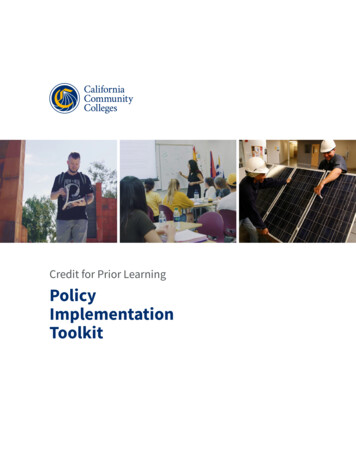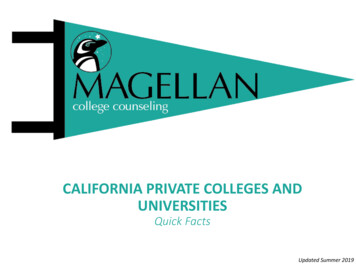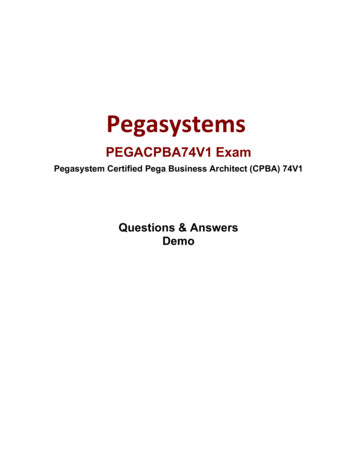
Transcription
Credit for Prior LearningPolicyImplementationToolkit
AcknowledgmentsThis toolkit was developed in 2020 as a joint project between the CaliforniaCommunity Colleges Chancellor’s Office and the Success Center at the Foundation forCalifornia Community Colleges through generous support from Lumina Foundation.CREDIT FOR PRIOR LEARNING: POLICY IMPLEMENTATION TOOLKIT
ContentsINTRODUCTION.1ABOUT THIS TOOLKIT.3CPL Initiative Advisory Committee.3Palomar College Pilot.3Discipline Cross-Walk Pilot.3WHAT IS CPL.4CPL Definition.4CPL Policy Standards.5IMPLEMENTING POLICY.6Process Flow.6Suggested Stakeholder List.6Sample Board Policy and Administrative Procedures.6IMPLEMENTING PROCEDURES.7Sample Student Process Flow.7Course Eligibility Template.7Cross-walk Template.7Cross-walks.7FAQ.8ASSESSING PRIOR LEARNING.9Portfolio Assessment Rubric.9CPL INITIATIVE ADVISORY COMMITTEE RECOMMENDATIONS. 10Awarding Credit.10Transparency and Accessibility.10Student Supports.11Professional Development.11Transfer.11Finance.12Policy Review.12APPENDIX. 13CREDIT FOR PRIOR LEARNING: POLICY IMPLEMENTATION TOOLKIT
IntroductionCredit for prior learning (CPL) is credit awarded for validated college-level skills and knowledge gainedoutside of a college classroom—it’s a strategy to grant students credit for what they already know andcan do. Across the nation, individual institutions and systems of higher education are implementingcomprehensive CPL practices to help working adults reskill and achieve quality credentials that increasetheir economic mobility. On September 16, 2019, the Board of Governors of the California CommunityColleges approved a revision to Title 5, Section 55050 that redesigns how students at CaliforniaCommunity Colleges receive credit for prior learning. The new regulation aims to make the process moreconsistent and equitable for students who come to community colleges with college-level skills andknowledge acquired in a variety of non-classroom settings. Research suggests that CPL benefits studentsand colleges by increasing completion and closing achievement gaps. In California, this means CPL canhelp the system achieve the goals outlined in the Vision for Success and increase college funding throughimproving measures on the Student Centered Funding Formula metrics.Research indicates that students who earn CPL: are roughly twice as likely to complete a degree than those who do not accumulate more credits through coursework at the institution than their counterparts, whichtranslates to increased enrollment for colleges save an average of 6-10 months in time to degree compared to their non-CPL counterpartsThere are a significant number of current and potential students who could benefit from CPL. About 42%of students enrolled in California community colleges in fall 2017 were over age 25 —many of whom holdindustry certifications, are graduates of public service academies, and were trained for military serviceoccupations, for example. A much broader population of potential students without degrees could alsobenefit: More than 6.8 million Californians age 25-54 have a high school diploma, some of whom attemptedcollege but none of whom earned an associate degree or higher Nearly three-quarters of this population is employed, 79% of whom are working 31 or more hoursper week On average, 8% of adults are enrolled in a postsecondary institution About 4% (272,000) of the target population have military experience. About 8% of the targetpopulation with military experience (21,760) are enrolled in any postsecondary institution More than half of the target population are people of color; using CPL to advance them towardscertificates and degrees could help reduce equity gapsCPL is an important equity imperative integrated within the Vision for Success. California’s working adults,predominantly people of color, need on-ramps to education and off-ramps to work to stay competitive inthe future workforce. CPL makes it easier for learners to get a jumpstart towards a certificate or degree; inaddition, validating their skills and knowledge with credit is a valuable signal that they belong in college.As a system, we must tailor learning and supports to help Californians upskill for future jobs. This toolkit ismeant to help colleges implement CPL as consistently as possible to achieve these goals.CREDIT FOR PRIOR LEARNING: POLICY IMPLEMENTATION TOOLKIT1
Colleges can contribute toVision for Success goals byoptimizing student successinitiatives for working learners.
About This ToolkitThe purpose of this toolkit is to provide resources and examples to aid implementation of CPL accordingto Title 5, Section 55050. College stakeholders are encouraged to view these resources and examples as astarting point. Recommendations and artifacts in this toolkit are derived from three sources:CPL Initiative Advisory CommitteeThe Lumina Foundation provided funding to the Success Center at the Foundation for CaliforniaCommunity Colleges (FoundationCCC) to create a policy and resource infrastructure to expand CPL inour system. The initiative—led by Vice Chancellor Alice Perez with the support of the Success Center—convened a statewide CPL Advisory Committee to inform recommendations to help students have moreequitable opportunities to earn CPL. Recommendations that were appropriate to implement at the statelevel were incorporated into Title 5, Section 55050. The rest can be considered guidance for local policyand practice and are included in this toolkit (see page 10 “Advisory Committee Recommendations”). TheCPL Initiative also seeded two pilots to bolster implementation of CPL.Palomar College PilotPalomar College piloted implementation of CPL through a cross-role task force operating in the 2019-20academic year. FoundationCCC helped the Palomar team document their college-wide implementationprocess, captured lessons learned, and incorporated the tools and examples included in this toolkit.Discipline Cross-Walk PilotIn a faculty-driven pilot supported by the Academic Senate for California Community Colleges andthe Chancellor’s Office, approximately 20 faculty members in seven disciplines over the 2019-20 yearconsidered how military training, industry certifications, and standardized exams could be consideredfor credit in their disciplines. In some cases, they compared (or “cross-walked”) the student learningoutcomes of courses to common prior learning experiences, such as military training or industrycertifications, and made recommendations based on the alignment. The cross-walks are available asstarting points for other faculty to consider (see page 27).All resources are available for download, editing,and repurposing in the CPL Community on theVision Resource Center.CREDIT FOR PRIOR LEARNING: POLICY IMPLEMENTATION TOOLKIT3
What is CPLCPL DefinitionCredit for prior learning is college credit awarded for validated college-level skills andknowledge gained outside of a college classroom.Students’ knowledge and skills might be gained through experiences such as: Military training Industry training State/federal government training Volunteer and civic activities (e.g. Peace Corps) Apprenticeships, internships, work-based learning, or otherindustry-basedexperiential learningCPL is not awarded for knowledge and skills already assessed and awarded credit throughformal education at regionally accredited in-state and out-of-state institutions.CREDIT FOR PRIOR LEARNING: POLICY IMPLEMENTATION TOOLKIT4
CPL Policy Standards1The Chancellor’s Office encourages all districts to elevate the following principles in their CPL policiesin order to ensure equity in the process of students obtaining CPL, and quality, integrity and rigor inassessment of prior learning:STANDARD ONE: EQUITYCPL policy ensures that all students have equitable access to consistent opportunities to earn credit forprior learning.STANDARD TWO: PHILOSOPHY AND ACADEMIC FRAMEWORKCPL policy is grounded in the institution’s philosophical and academic framework and is consistent withinstitutional mission, goals, and approaches to learning.STANDARD THREE: INTEGRITYCPL policy ensures that all stakeholders (including faculty, institutional representatives, students, and anyexternal contributors) promote integrity in the evaluation and documentation of prior learning.STANDARD FOUR: FACULTY QUALIFICATIONSCPL policy assures the involvement of qualified discipline faculty and the preservation of discipline facultypurview over the awarding of credit.STANDARD FIVE: STUDENT SERVICESCPL policy assures that students have timely and continuous access to transparent information, resources,and services to guide them on CPL.STANDARD SIX: CREDIT MANAGEMENTCPL policy clearly identifies how credits are organized and applied to student records.STANDARD SEVEN: PLANNING, RESOURCES, IMPROVEMENTCPL policy assures continuous improvement and scalability of processes by providing sufficientinfrastructure and data to support policy implementation and review.1Standards based on Brewer, Patricia and Lakin, Mary Beth. (2018). Credit for Prior Learning: Putting Standards for Policy in Place.American Council on Education: Washington, D.C. Retrieved from 135/173CREDIT FOR PRIOR LEARNING: POLICY IMPLEMENTATION TOOLKIT5
Implementing PolicyAll resources outlined in this and following sections can bedownloaded from the Vision Resource Center CPL Community.Process FlowThis suggested process flow outlines steps and tactics a college may take to develop and implement CPLpolicy and procedures. The step-by-step process encompasses everything from recruiting a cross-role taskforce to communicating CPL procedures to students.(See pages 14-15)Suggested Stakeholder ListThe development of a successful CPL policy and procedure will take the collaboration of manystakeholders – this suggested list is a starting point to consider involving in development of a district CPLpolicy.(See page 16)Sample Board Policy and Administrative ProceduresColleges can use Palomar’s Board Policy and Administrative Procedures (BP/AP) as a reference as theywork to revise their own policies to meet the needs of their students and local context. Palomar startedby taking their Credit by Exam BP/AP and met with stakeholders to revise the policy to a broader contextthat included the other forms of prior learning assessment (PLA). As these revisions were drafted, keystakeholders were consulted to provide feedback and capture critical elements across program areas.(See page 17-22)CREDIT FOR PRIOR LEARNING: POLICY IMPLEMENTATION TOOLKIT6
Implementing ProceduresSample Student Process FlowThe Vision for Success calls on stakeholders to “design and decide with the student in mind.” Collegesshould center CPL procedures on the student experience. This sample process flow outlines how studentswould experience the CPL process at Palomar College.(See pages 23-24)Course Eligibility TemplateOnce a CPL policy has been established on a campus, it is beneficial to put into place processes that makethe policy scalable across disciplines. This sample Course Eligibility Approval template enables facultyto propose CPL for a course. The template establishes criteria for eligibility, approval procedures, andprocedures to ensure that the course’s eligibility is updated in the appropriate systems.(See page 25)Cross-Walk TemplateThe Cross-Walk Template can be used to identify the types of prior learning assessments that could beused to award credit in courses. The template suggests various prior learning assessment methods andcan be used in conjunction with the sample cross-walks developed in the statewide pilot (see page 27).The Cross-Walk Template is a useful tool for larger groups such as CPL task forces or by individual or smallfaculty discipline teams.(See page 26)Cross-walksCross-walks are a mechanism to help faculty examine common learning experiences offered bygovernment agencies or professional organizations and compare (or “cross-walk”) the competenciesachieved in those experiences with student learning outcomes of aligned courses. Faculty can accesscredit recommendations of third-parties such as the American Council on Education (ACE), which hasevaluated thousands of military training programs. The goal of developing cross-walks is to get as muchconsistency as possible in credit awards for common learning experiences. The cross-walks providedin this toolkit were developed by California community college faculty participating in the statewidepilot and can be used as a starting point for college faculty to consider. The cross-walks are available fordownload in the CPL Community on the Vision Resource Center.CREDIT FOR PRIOR LEARNING: POLICY IMPLEMENTATION TOOLKIT7
SUGGESTED STEPS TO DEVELOP YOUR OWN CROSS-WALK:STEP 1Convene discipline faculty and student learning outcomes experts at your college.STEP 2Ask faculty to identify common prior learning experiences in their discipline such as aligned industrycertifications, military training programs, public service academies, workplace training, civic service, etc.STEP 3Ask faculty to consult third-party credit recommendation guides like American Council on Education (ACE),or consult industry experts, workplace trainers, or other educators to learn about what competenciesstudents achieve in the identified prior learning experiences.STEP 4Identify courses where the student learning outcomes might be aligned with those competencies. If facultyhave already completed their CPL Cross-walk, use that document as a resource in the discussion.STEP 5Compare the competencies achieved in the prior learning experiences to the student learning outcomes inaligned courses.STEP 6Consider what is required in the course for the student to demonstrate “sufficient mastery.” If “sufficientmastery” can be demonstrated through participation in the prior learning experience, then determine howfaculty should assess the student for credit (note: keep in mind that the student’s burden of proof shouldbe just enough to demonstrate sufficient mastery). This might include showing documentation such astest scores, certificates of completion, or Joint Services Transcript, or completing a skills demonstration, aportfolio, or another type of assessment that the faculty deems appropriate.STEP 7Outline the recommended prior learning assessment method and credit recommendation on the CPLCross-walk form.(See pages 27-31)FAQThis Frequently Asked Questions (FAQ) template provides a starting point of questions to expect to answeras you develop and implement CPL policy on your campus. Having clear and consistent answers will assistin building support for the work among stakeholders and reduce points of confusion.(See pages 32-33)CREDIT FOR PRIOR LEARNING: POLICY IMPLEMENTATION TOOLKIT8
Assessing Prior LearningPortfolio Assessment RubricThis sample rubric, developed by faculty at Palomar College, provides an example of how portfolioscan be assessed to determine if credit should be awarded for prior learning. The rubric can be used as astarting point for colleges to consider and modify based on their student learning outcomes and criteriaof learning. Discipline faculty and student learning outcome experts are encouraged to participate in thedevelopment and/or approval of rubrics.(See pages 34-35)CREDIT FOR PRIOR LEARNING: POLICY IMPLEMENTATION TOOLKIT9
CPL Initiative Advisory Committee RecommendationsAfter reviewing CPL policies and practices from systems across the country, the CPL Advisory Committeemade the following recommendations:Awarding Credit Students’ educational goals should be the guiding factor in the award of credit. Students should be able to have their prior learning assessed early in their educational journey andprior to registering for a course. They should be able to access clear timelines and processes toward receiving a creditrecommendation. When setting limits on CPL, rely on existing minimum/maximum credit allowances already stipulatedin transfer policy. Follow accreditation requirements. If a student seeks credit for a course that a college does not have in its catalog (i.e. Russian language),consider connecting the student to faculty at a college where the course is offered. The student maybe eligible to complete a prior learning assessment there. Students should be advised of the recommended credit before it is officially awarded. Title 5 Section55050 allows students to accept, decline, or appeal decisions on assessments in order to protect theirfinancial aid or veteran’s benefits. Students, informed by a counselor, should decide when credit is applied. Each district should consider whether its faculty will assess prior learning of students who are not yetenrolled. CPL can be a benefit to attract potential students. Each district should consider setting a time limit for how long prior learning remains valid and eligiblefor assessment for credit.Transparency and Accessibility Students have a right to receive information on CPL; doing so puts the burden on institutions to betransparent. Engage stakeholders early and often in the development of CPL policy, which could increase buy-in. CPL policies and communications should stipulate that CPL should be transparent and accessible toall stakeholders, including current and potential students, faculty, staff, administrators, industry, andother community partners. Stakeholders should clearly understand how CPL impacts student success, college completion ratesand enrollment, course scheduling, and student diversity. CPL should be clearly identified as curriculum under faculty purview per title 5. Clear guidelines for faculty in prior learning assessment will help them trust their colleague’scredit award decisions. Students need easy access to a resource on CPL at a college, such as a website that explains CPL, whyand how it’s available, who to contact, what process to expect, what types of prior learning mightqualify for credit, etc.CREDIT FOR PRIOR LEARNING: POLICY IMPLEMENTATION TOOLKIT10
Student Supports Counselors should be at the center of informing students about CPL. Inform students about CPL during matriculation and placement activities or processes. Integrate prior learning assessment advising into educational planning. Integrate CPL with Guided Pathways. Identify opportunities for CPL within mapped pathways andmake that information available to students. For example, a CompTIA certification might make astudent eligible for credit in the Information Technology certificate and degree pathways. Develop a clear process flow for students, including steps and timeline, so that students can managetheir expectations. Within the process flow, identify key decision points for the student so that institutions know whenaction is required by internal stakeholders. Assign staff to operate as a CPL coordinator at each college. There may be an opportunity to leveragestaff formerly assigned to assessment and placement.Professional Development Provide professional development (PD) training and webinars so that faculty are equipped to identifyopportunities for CPL, conduct crosswalks to determine credit recommendations, and apply thecredit consistently for all students. Incorporate PD on CPL into Guided Pathways professional development. Work with your local Academic Senate representatives to set standards for faculty in conducting priorlearning assessment. Clear guidelines for faculty in prior learning assessment will help them trusttheir colleague’s credit award decisions. All stakeholders on campus who are affected by CPL (admissions, registrar, institutional research,faculty, etc.) should be aware of their roles and responsibilities related to CPL and should be able toadvise students on process. Consider convening a CPL conference or workshop for faculty or staffinvolved with CPL. Consider holding a CPL conference or workshop for faculty or staff involved with CPL. Make faculty training on CPL a part of “flex day” programming. Find resources through organizations such as the Council on Adult and Experiential Learning (CAEL)and the American Council on Education (ACE).Transfer Colleges should recognize and accept CPL awarded at other California community colleges. Colleges are encouraged to work closely with their intersegmental partners to ensure credit will beaccepted for transfer.CREDIT FOR PRIOR LEARNING: POLICY IMPLEMENTATION TOOLKIT11
Finance Use existing funding from programs where objectives are aligned. Colleges could leverage existingprogram funds such as Student Equity and Achievement (SEA) Program, Guided Pathways, andStrong Workforce, among others. Leverage funding from community industry partners, particularly when awarding credit for industrycertifications.Policy Review Title 5 Section 55050 requires that policies be reviewed every three years. Therefore, local policylanguage should set some expectation for an evaluation process, potentially including elements suchas a review timeline, stated goals, and what factors will be assessed. CPL review should include qualitative data from students and “content experts” suchas faculty. Successful review processes include active involvement from key stakeholders such as AcademicSenate, the Associated Student Government, and allow for local flexibility. Evaluation methods should enable greater understanding of the impact of CPL onequity gaps.CREDIT FOR PRIOR LEARNING: POLICY IMPLEMENTATION TOOLKIT12
AppendixThe resources are not depicted in their entirety in this Appendix due to their size and complexity. The fullresources are available for download from the Vision Resource Center CPL Community.Implementing policy Process Flow Suggested Stakeholder List Sample Board Policy and Administrative ProceduresImplementing procedures Sample Student Process Flow Course Eligibility Template Cross-walk Template Cross-walks FAQAssessing prior learning Portfolio Assessment RubricCREDIT FOR PRIOR LEARNING: POLICY IMPLEMENTATION TOOLKIT13
SUCC E S SC E NforT E RCA L I F O R N I A C O M M U N I T Y C O L L E G E SCR E D I T F O RP R I O R LEARNINGI NI T I AT I V EPROCESS FLOWThis process flow outlines steps and tactics a college may take to implement credit for prior learning—a strategy usingstudents’ previously acquired skills and knowledge to accelerate their paths to completion. Find more resources,including templates (underlined below), in the Credit for Prior Learning Community on the Vision Resource Center.Step 1GOALDevelop a College Creditfor Prior Learning (CPL)Workgroup.STRATEGIES Identify stakeholderson campus withvarying expertise andperspectives, such as:o Student services facultyo Instructional facultyo AdministratorsStep 2Step 3GOALDevelop an engagementplan to enable multidirectional dialogueabout CPL.GOALDevelop meeting cadenceand key communicationartifacts for stakeholderengagement.STRATEGIESSTRATEGIES Identify affectedstakeholders and developsuggested roles for themin CPL implementation. Involve accreditationrepresentation.o Student Learning Outcome(SLO) coordinators Identify a CPL lead to beresponsible for advancingthe outcomes of theworkgroup. Be realisticabout the time thisperson will commit andconsider institutionalizingthe position. Marshall resources tosupport the workgroupand campus CPLefforts, such as GuidedPathways or StudentEquity and AchievementProgram funds. Hold brainstormingsessions to addresschallenges, opportunities,questions, and concernsabout engaging identifiedstakeholders. Use group meetings todevelop shared goals forthe workgroup and forCPL implementation. Develop an FAQ to answerstakeholder questionsand provide consistency. Develop a FrequentlyIdentified Concerns (FIC)document to identifyfuture issues, demonstratewillingness to hearstakeholders and intentto increase buy-in.Step 4GOALDraft a Student ServicesCPL Process.STRATEGIES Hold meetings toanalyze procedures forCPL intersections. Identify existing studentdata needed for CPL andwhat new data variablesshould be created to tracksuccess of CPL impact. Develop a list of CPLdata elements. Use lean processmapping to check forredundancies or conflicts.Step 5GOALDevelop a plan tocommunicate with studentsabout CPL.STRATEGIES Meet with the campus ITteam to discuss informationsystems infrastructure. Establish when/wherestudent data will begathered, and when/where it will be linkedto other student data. Determine how the processcan be automated orcompleted electronically. Build consensus arounda central entry point forimplementing CPL. Develop a CPL intake form. Consider using GPor SEA funds.CREDIT FOR PRIOR LEARNING: POLICY IMPLEMENTATION TOOLKIT14
SUCC E S SC E NforT E RCA L I F O R N I A C O M M U N I T Y C O L L E G E SStep 6CR E D I T F O RP R I O R L E ARNINGI NI T I AT I V EStep 7Step 8GOALDevelop a timeline for boardpolicy and administrativeprocedure developmentand adoption.GOALCreate a cross-walk ofcourses eligible for CPL andthe types of prior learningassessments required.GOALAdvance revised boardpolicy and administrativeprocedures through sharedgovernance processes.STRATEGIESSTRATEGIESSTRATEGIES Identify the date thatfinal revisions needto be completed. Develop a scheduleworking backwards fromthe final revisions date. Identify any dependenciesthat could affectthe timeline. Develop a CPL crosswalk template to beused across meetingsand individual work. Collaborate with facultyto identify types of priorlearning assessments thatwould be required to awardCPL in select courses.This requires consideringhow the assessmentreveals whether a studentacquired the course’sstudent learning outcomes. Use the cross-walktemplate when workingwith faculty to identifycourses that could beawarded through thevarious types of CPL. Share with key stakeholdersand incorporate feedback.PROCESS FLOWStep 9GOALDevelop a process for CPLassessment developmentand approval with reviewsfrom faculty, administrators,IT, evaluators, and StudentLearning Outcome subjectmatter experts.STRATEGIES Build consensus forcollaborative developmentof prior learningassessment processes. Develop rubrics forassessments, such asevaluating portfoliosor Joint ServicesTranscripts. Highlightthe need for professionaldevelopment for faculty.Step 10GOALDevelop a plan tocommunicate with thecampus communityabout CPL.STRATEGIES Develop resources suchas a website, short videos,or workshops to explainCPL opportunities tostudents, using languagethat is accessible andeasy to understand. Use existing infrastructureto send information, suchas student newsletters,text or email, clubs, etc. Use ACC & JC standardsto continually informyour process. Brainstorm and buildconsensus for the process. Schedule a recurringreview process aligned toprogram evaluations orchan
Colleges approved a revision to Title 5, Section 55050 that redesigns how students at California Community Colleges receive credit for prior learning. The new regulation aims to make the process more consistent and equitable for students who come to community colleges with college-level skills and










